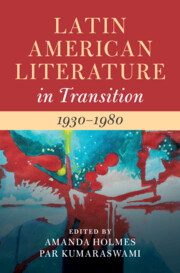Book contents
- Latin American Literature in Transition 1930–1980
- Latin American Literature in Transition
- Latin American Literature in Transition 1930–1980
- Copyright page
- Contents
- Contributors
- Introduction
- Part I War, Revolution, Dictatorship
- Part II Metropolis and Ruins
- Part III Solidarity
- Part IV Aesthetics and Innovation
- Chapter 14 Eros
- Chapter 15 The Return of the Galleons
- Chapter 16 “Un Híbrido de Halcón y Jicotea”
- Chapter 17 Literature and Revolution in Transition
- Chapter 18 Divergence and Convergence
- Chapter 19 Cortázar’s Transitional Poetics
- Index
- References
Chapter 17 - Literature and Revolution in Transition
An Aesthetics of Singularity
from Part IV - Aesthetics and Innovation
Published online by Cambridge University Press: 24 January 2023
- Latin American Literature in Transition 1930–1980
- Latin American Literature in Transition
- Latin American Literature in Transition 1930–1980
- Copyright page
- Contents
- Contributors
- Introduction
- Part I War, Revolution, Dictatorship
- Part II Metropolis and Ruins
- Part III Solidarity
- Part IV Aesthetics and Innovation
- Chapter 14 Eros
- Chapter 15 The Return of the Galleons
- Chapter 16 “Un Híbrido de Halcón y Jicotea”
- Chapter 17 Literature and Revolution in Transition
- Chapter 18 Divergence and Convergence
- Chapter 19 Cortázar’s Transitional Poetics
- Index
- References
Summary
This essay focuses on Nellie Campobello and Juan Rulfo to study how the Mexican Revolution by midcentury produced a singular aesthetic form in the guise of the unique short story or narrative sketch. This process involves a violent segmentation of the common, together with a no less forceful production of the singular. While Campobello and Rulfo tap into the resources of collective storytelling, they subject these oral materials to a process of aestheticization whose fundamental values lay in an image of self-standing beauty, or singularity, rather than community. Literature, even when its topic is the aftermath of the revolution, thus seems to run counter to the latter's ideals of collectivization. The chain of oral storytellers is typically interrupted with the appropriation of orality on behalf of an individual author with a unique signature. Based on the examples of Campobello and Rulfo, we might even ask whether there ever was such a thing as a novel of the Mexican revolution to begin with: not only because their sketches and short stories hardly can be considered novels but also because theirs amounts to a narrative of the counter-revolution.
Keywords
- Type
- Chapter
- Information
- Latin American Literature in Transition 1930–1980 , pp. 275 - 289Publisher: Cambridge University PressPrint publication year: 2022

